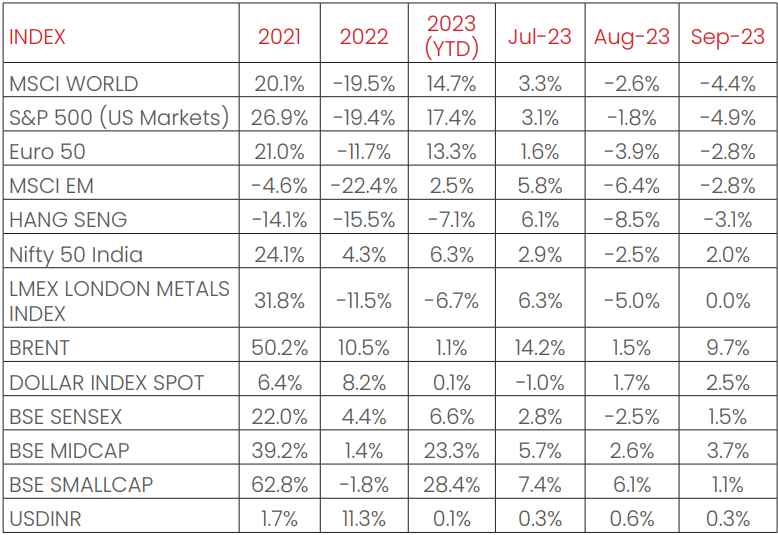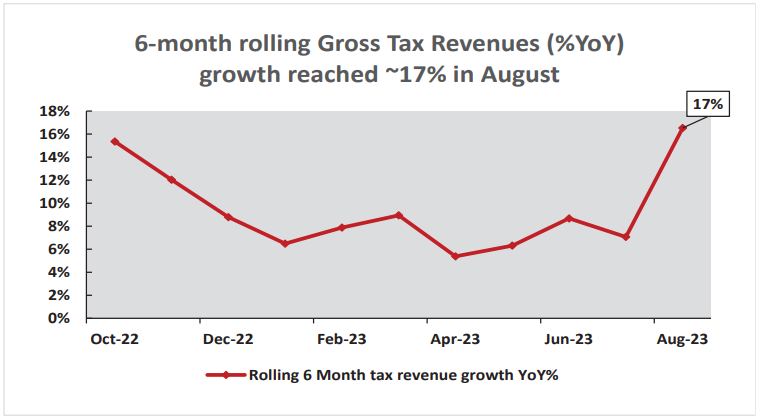
Macro and
Equity Market
Outlook
Equity Market
Outlook
GLOBAL MACRO &
MARKETS – September 2023
India’s S&P Nifty 50 index ended the month with 2.0% gains in
September. The S&P500 (-4.9%), the Euro 50 (-2.8%), the MSCI World
(-4.4%), Japan’s Nikkei (-2.3%) all ended the month negative, as
global markets faced a tumultuous month. Among emerging
markets indices, the MSCI EM, the HANG SENG, and the MOEX Russia
corrected marginally in September, by -2.8%, -3.1%, and -2.9%
respectively. BOVESPA Brazil bucked the negative trend, with +0.7%
MoM (month on month).
LME (London Metal Exchange) Metals Index remained flat in
September, as China’s Manufacturing PMI (Purchasing Manager's
Index) deteriorated slightly for September but remained in
expansion (>50). WTI and Brent Crude continued to rise in
September, by +8.6% and +9.7% respectively, as supplies remained
tightened on account of Saudi Arabia and Russia’s output cuts that
are expected to run through to the end of the year, and demand
growth remains stable. Saudi Arabia also hiked its official selling
price for the commodity, providing a fillip to the commodity’s price
levels, even as an uncertainty in Macro outlook remained. The
Dollar index strengthened by +2.5% over the month, with the Dollar
depreciating by -2.0% vis-à-vis EM currencies and appreciating by
+0.3% against the Indian Rupee. India 10Y G-Sec yields rose slightly,
rising by +5 bps, while US 10Y G-Sec yields rose by +46 bps, and the
German Bund rose by 37 bps, with rates settling at 7.21%, 4.57% and
2.83% respectively. US Yields rose to highest levels in 20 years.
Domestic Macro &
Markets - September 2023
The BSE SENSEX (+1.5%) rose in September, in tandem with other
benchmark Indian indices. BSE Mid-cap outperformed the SENSEX
and was up +2.6%. The BSE Small Cap index was up by +1.1 m/m.
Sector-wise, BSE PSU, Power, Metals and Capital Good indices were
the top 4 gainers over the month, with gains of +10.6%, +7.1%, +6.4%,
+5.6% over the month. All major sector indices ended the month in
green, rounding off a stellar month for Indian equities.
Net FII flows, were negative for September (-$1.8Bn, following +$1.2
Bn in August). DIIs turned into net buyers of Indian equities (+$2.6
Bn, up -$0.3 Bn from last month).

India's high frequency data update:
Elevated levels of GST collections, tolerable retail inflation, deflated
input cost inflation, rising core sector outputs, and elevated credit
growth augurs well for the Indian economy.
Manufacturing PMI (Purchasing Manager's Index):
Manufacturing PMI in September came in at 57.5, down from 58.6 in
August, and remained in expansion zone (>50) for the 27th straight
month, as output expanded at the slowest level in 5 months given a
tepid rise in new orders. Output gained for the 27th straight month,
and export sales growth cooled off a 9 month high the previous
month. Buying levels remained elevated, with confidence rising to
highest levels in CY2023.
GST Collection:
Collections of INR 1.62 Tn (+10% YoY) in September concluded the
nineteenth consecutive month of collections over the INR 1.4 Tn
mark, the fourth highest recorded since the inception of the
regime, following record collections of INR 1.87 Tn in April. The
average monthly gross collection this fiscal is INR 1.65 Tn (+11% YoY
from the same fiscal period last year). Rising compliance, rising
formalization of the economy, festive demand, and improved
administrative efficiency have driven sustainedly high levels of GST
collections.
Core sector production:
Core sector production growth shot up to 12.1% in August, against
an 8.0% (Revised later to 8.4%) jump in July 2023, as a favourable
base effect came into play for India’s eight core sectors. All the
eight constituent sectors recorded positive YoY growths, with
cement and coal production rising by 18.9% and 17.9% respectively.
Industrial Production:
Factory output as measured by the IIP index accelerated to 5.7%
YoY in July vs a growth of 3.8% YoY (upwardly revised by 10 bps) in
June 2023, buoyed by growths in all 3 constituent sectors- Mining
output growth accelerated +10.7% while manufacturing output
grew by 4.6% YoY, and Electricity output hastened to 8% in July.
Credit growth:
Scheduled Commercial Bank Credit growth reached 19.96% YoY as
of 22nd September 2023 against YoY growth of 16.44% as observed
on 23rd September 2022.
Inflation:
August’s CPI inflation rate remained above the RBI’s comfort zone
of 6% and reached 6.83%, easing from 7.44% in July, which came in
at a 15-month high. Acceleration in the CPI rate was attributed to
food basket inflation, which came in at 9.94% in August, compared
to the 11.51% rise in July. WPI (Wholesale Price Index) inflation
remained in negative territory, with the August print at a
five-month high of -0.52%, 83 bps up from July’s at -1.36%, as food,
fuel and manufactured products remained in the deflation zone.
This was the fifth straight month of deflation witnessed.
Trade Deficit:
Indian Merchandise Exports recorded a decline of -6.9% YoY to
$34.48 Bn in August, while Imports growth declined by -5.2% YoY to
$58.64 Bn. India’s trade deficit widened to a 10-month high of $24.2
Bn as the rupee weakened and oil prices surged.
Key Market Developments that may be tracked
in October 2023:
Oil Prices:
Oil markets continued surging in September as supply curbs from
key OPEC+ members pressurised physical markets. A poor print for
US gasoline consumption and rising inventories have dampened
the demand outlook, even as rising oil prices cut back into the
pockets of households globally. WTI Crude’s implied volatility
gauge is at local maxima for the year.
Global Bond Yields:
The USA’s benchmark bond yield, the Treasury yield rose to 4.6% in
September. As Central banks transition to the apogee of their
interest rate hiking cycles, with high levels of decoupling, bond
market volatility is rising. US Treasury inflation protected securities
(TIPS), used as a proxy for real interest (inflation adjusted) rates in
the economies are touching 2007 levels as markets are pricing in
various near-term triggers that elevate yields along with the
“higher for longer” policy advocated by central banks. Expanding
US budget deficits, unwinding demand for Treasury securities from
foreign investors including China and expectations and Japanese
monetary tightening in the coming quarters remain key
monitorable for markets.
Festive Season demand:
As India gears up for the festive season, demand in cyclical
industries will be a key monitorable for market participant. Boosted
demand will also play into rising indirect tax levels as the demand
outlook based on various gauges remains healthy.
RBI MPC Meet:
The RBI delivered a hawkish tone on 6th October, as it maintained
the benchmark repo rate unchanged at 6.5%, while reasserting a
stance of “withdrawal of liquidity”. The RBI governor pronounced
that inflation remains uncomfortably high, much above the
“target” of 4%. The RBI governor also highlighted crude and food
inflation as key risks for the inflation trajectory in India, as the prices
of crude remain elevated and weak rainfall plays into food prices.
Events to watch out for:
Q2FY24 earnings season in India and global earnings for 3QCY23
are important to track in coming month. Globally, China related
news flow is important to track from emerging markets
perspective.
Monthly Performance for Key Indices:

Note: Market scenarios are not the reliable indicators for current or future
performance. The same should not be construed as
investment advice or as any research report/research recommendation.
Past performance may or may not be sustained in future.
Source: Bloomberg
Past performance may or may not be sustained in future.
Source: Bloomberg
Market View
Global economic trends remain mixed and challenging.
Geopolitical challenges in addition to pressures on account of
higher interest rates and its impact on growth and returns continue
to remain. Domestic market rally has been driven by strong macro
fundamentals, robust foreign and domestic flows and healthy
earnings growth. While all the major indices are trading near
all-time highs, the run up in mid/ smaller capitalization companies
has been very sharp. What has worked for mid and small caps is the
broad basing of the market earnings and healthy balance sheets.
Local events like forthcoming state & general elections, global
developments like rising crude oil prices, mixed signals on global
growth etc appears to be ignored in the current euphoria. Large
Caps appear to be better positioned on a relative basis and along
with Asset Allocation products like Multi Asset Funds, Balanced
Advantage etc may assist to manage the near term risks. Investors
apprehensive of the equity market swings can consider
participating in a staggered manner in line with their risk appetite
and investment goals.
Note: The sectors mentioned are not a recommendation to buy/sell in the said sectors.
The schemes may or may not have future
position in the said sectors. For complete details on Holdings & Sectors of NIMF schemes, please visit
website mf.nipponindiaim.com.
Past performance may or may not be sustained in future
Past performance may or may not be sustained in future
Chart of the month :
The Centre’s gross tax revenue rose by ~17% YoY in 5MFY24 as
corporate taxes rebounded allowing for continued front-loading of
capital expenditure.

Common Source:
NIMF Research, CMIE, Bloomberg
Disclaimer: The information herein above is meant only for general reading purposes
and
the views being expressed only
constitute opinions and therefore cannot be considered as guidelines, recommendations or as a
professional guide for
the readers. The document has been prepared on the basis of publicly available information, internally
developed data
and other sources believed to be reliable. The sponsors, the Investment Manager, the Trustee or any of
their directors,
employees, Associates or representatives (‘entities & their Associate”) do not assume any
responsibility
for, or warrant the
accuracy, completeness, adequacy and reliability of such information. Recipients of this information
are
advised to rely on
their own analysis, interpretations & investigations. Readers are also advised to seek independent
professional advice in
order to arrive at an informed investment decision. Entities & their associates including persons
involved in the preparation
or issuance of this material, shall not be liable in any way for any direct, indirect, special,
incidental, consequential, punitive
or exemplary damages, including on account of lost profits arising from the information contained in
this material.
Recipient alone shall be fully responsible for any decision taken on the basis of this document.
